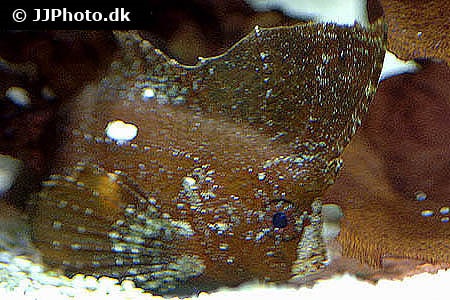Ablabys taenianotus

| Latin name | Ablabys taenianotus - (Cuvier, 1829) |
|---|---|
| Local name | Cockatoo waspfish |
| Family | Tetrarogidae - Ablabys |
| Origin | Australia, Japan, Indonesia, Central/West Pacific |
| Max length | 15 cm (5.9") |
| Minimum volume |
100 l (26 gal) |
|---|---|
| Hardiness |
Average |
| Suitable for aquarium |
Suitable for special aquariums |
| Reef safe |
Reef safe with caution |
| Aggressiveness | Docile but might be aggressive towards similar species of same gender |
| Recommended |
Fish Larger crustaceans (Shrimp, crabs...) |
|---|
This species demands a high water quality.
Amongst other things it means, that water must be properly oxygenated.
This species may eat small fish and especially small shrimps, there are, however, some aquarists who manage to get them to coexist just fine.
This species survives on bottom dwelling invertebrates and will not normally eat food that is not alive.
Be prepared to feed with small live shrimp, for example, for a long time.
Do be aware that food competitors do not reach the food first.
This species is highly venomous and this venom can, under certain circumstances, be fatal.
In case of poisoning, it is vital to have as much information as possible regarding the species/poison. Have telephone number for the poison hotline close to the aquarium.
Since people can have different reactions to poisons, take precautions necessary to ensure your safety and that of your surroundings.
They can live as a pair provided they are introduced simultaneously.
This species needs good hiding places, for example, between live rocks.
This species is very shy and docile, so one should be careful when keeping it with more aggressive fish.
Waspfish (Tetrarogidae) are typically found lying on the bottom, imitating algae or bits of debris. Some even have algae growing on them which means that algae eating fish can cause injury.
They feed mainly on small bottom dwelling crustaceans. They might try to catch fish but are not particularly adept at catching them. It is by no means certain they can get used to frozen foods, but one might be successful over time.
Waspfish are not particularly fast and therefore cannot compete for food with faster swimming fish and consequently will not do well. They do not normally pose a threat towards other animals in an aquarium, it is only small crustaceans and very small fish they will prey on.
They have very poisonous spines on their back and this, combined with their habit of camouflaging makes them dangerous when having bare hands in the tank. Take special care not to damage their spines when they need catching.
Anemones and corals that burn strongly can injure Waspfish.
| Aquarium trade | Yes |
|---|---|
| Distribution | Eastern Indian Ocean and Western Pacific: Andaman Sea to Fiji, north to Japan, south to Australia. Replaced by Ablabys binotatus in the western Indian Ocean (Ref. 9710). |
| Danish common names |
Kakaduefisk |
| English common names |
Cockatoo waspfish |
2009. Is a long-finned waspfish a "good" fish to keep? - Reef Central - (English)
Scott W. Michael. 2001. Reef Fishes volume 1 - TFH Publications / Microcosm Ltd. - (English)
Bob Fenner. The Waspfishes, Leaf Fish or Sailback Scorpionfishes - Wet Web Media - (English)

